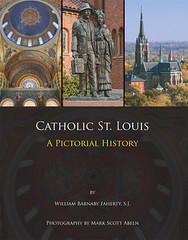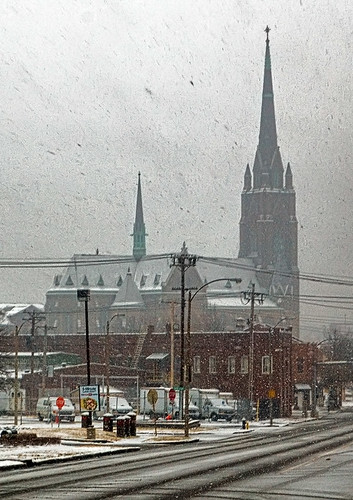The exhibition opens with a reception at 5:30 p.m. Friday, Feb. 26, and continues until Sunday, June 27.A Jesuit friend tells me that they have a larger number of young new Jesuit Scholastics they they have had in decades. May the Society have a glorious future in service of Christ and His Church.
Founded by Ignatius Loyola in the year 1534, the men of the Society of Jesus (the Jesuits) concentrated their efforts on foreign missions, education and scholarship. In the year 1823, a new generation of Jesuit missionaries arrived in St. Louis.
Like the Jesuit missionaries of old, these Jesuits were also keen observers of the people they encountered as well as the geography and ecology that differed so much from what they had known in Europe.
Friday, February 26, 2010
"Crossing the Divide: Jesuits on the American Frontier"
THE GLORIOUS PAST of the Society of Jesus is shown in a new exhibit opening tonight: "Crossing the Divide: Jesuits on the American Frontier", at the Saint Louis University Museum of Art. From the website:
Actus Contritionis
I HAD A DREAM, an odd one (but aren't all of them odd?), about three boys, who due to extreme negligence, wrecked their parents' car. Each boy had a different reaction:
Since this is the penitential season of Lent, let us consider the Act of Contrition, used during the Sacrament of Penance. Here is the Latin text:
This is an act of contrition, it being an act of the will: it is something that you choose to do freely. Perfect contrition is that which is motivated beyond mere reward or punishment.
Consider again why we should do good and to avoid wrong. Like the two older boys in my dream above, do we fear the loss of reward, or do we fear punishment? Of course we should, since we are human, and we can suffer real harm. Indeed, being indifferent to reward or punishment is a heresy, but so is being motivated only by reward or punishment.
Atheistic critics of Christianity will often say that Christians only follow a form of Utilitarianism, desiring to avoid punishment and hoping for reward, but as the Act of Contrition indicates, this is not true: we hate our sins before God because He is all good and fully deserving of all our love. True love for others is the mark of the Christian. The youngest boy in the dream got it right.
- The middle child feared punishment.
- The oldest child, who was driving, feared that his parents would revoke their promise to pay for his college education.
- The youngest child knew that his parents loved them and that they would be sad because of the three boys' disobedience.
Since this is the penitential season of Lent, let us consider the Act of Contrition, used during the Sacrament of Penance. Here is the Latin text:
Deus meus, ex toto corde poenitet me omnium meorum peccatorum,Now, according to the modern Rituale, there are various forms for the Act of Contrition, and there are translations of varying quality. Here is the one that I use:
eaque detestor, quia peccando,
non solum poenas a te iuste statutas promeritus sum,
sed praesertim quia offendi te,
summum bonum, ac dignum qui super omnia diligaris.
Ideo firmiter propono,
adiuvante gratia tua,
de cetero me non peccatorum peccandique occasiones proximas fugiturum.
Amen.
O my God,I have no idea where I originally found this text, and I have difficulty in finding official Church texts of the Ritual from the Vatican. However, a lawyer friend once told me that this is a very good form, since it enumerates all the elements needed for perfect contrition.
I am heartily sorry for having offended You,
and I detest all my sins,
not just because I fear the loss of Heaven and the pains of Hell,
but because You are all good and fully deserving of all my love.
I fully resolve, with the help of Your grace,
to confess my sins, to do penance, and to amend my life.
Amen.
This is an act of contrition, it being an act of the will: it is something that you choose to do freely. Perfect contrition is that which is motivated beyond mere reward or punishment.
Consider again why we should do good and to avoid wrong. Like the two older boys in my dream above, do we fear the loss of reward, or do we fear punishment? Of course we should, since we are human, and we can suffer real harm. Indeed, being indifferent to reward or punishment is a heresy, but so is being motivated only by reward or punishment.
Atheistic critics of Christianity will often say that Christians only follow a form of Utilitarianism, desiring to avoid punishment and hoping for reward, but as the Act of Contrition indicates, this is not true: we hate our sins before God because He is all good and fully deserving of all our love. True love for others is the mark of the Christian. The youngest boy in the dream got it right.
Thursday, February 25, 2010
Photos of the Pere Marquette Gallery
A FORMER LIBRARY at Saint Louis University was renovated in 1995 into the remarkable but largely unknown Pere Marquette Gallery. Located in DuBourg Hall and dating from 1886, the gallery is part of the Saint Louis University Museum of Art.
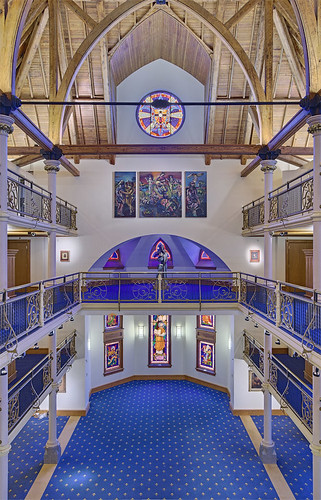
This great room is four stories tall. According to a history of the museum:
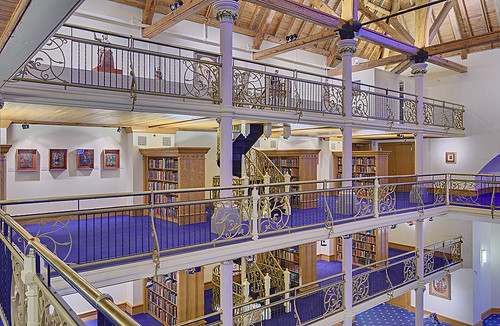
This still has books. I am normally a bookworm, but didn't have time to look at what volumes were stored here.
The history continues:
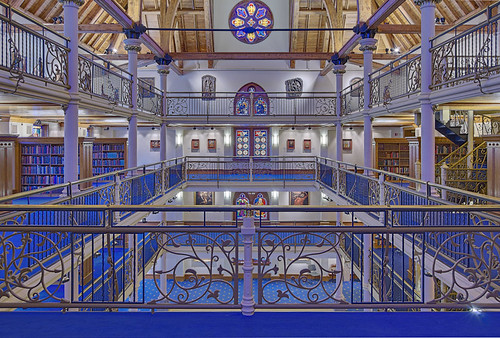
Continuing:
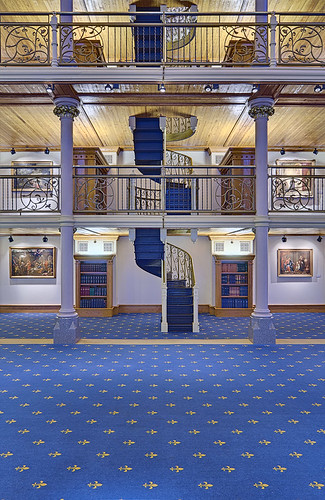
Spiral stairs lead upwards. Note the gold fleurs-de-lis on the rich blue carpeting, which reflects the royal French history of this region.

A view of the ceiling.
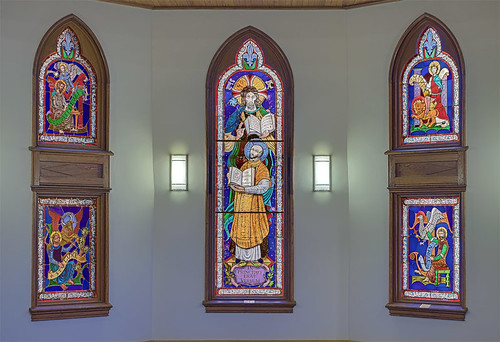
Stained glass window in the center shows Christ Pantocrator and Saint Francis Xavier; flanking windows show the Evangelists.
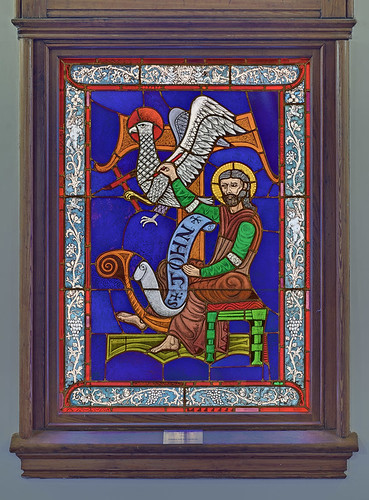
Saint John the Apostle and Evangelist, with his symbol the eagle.
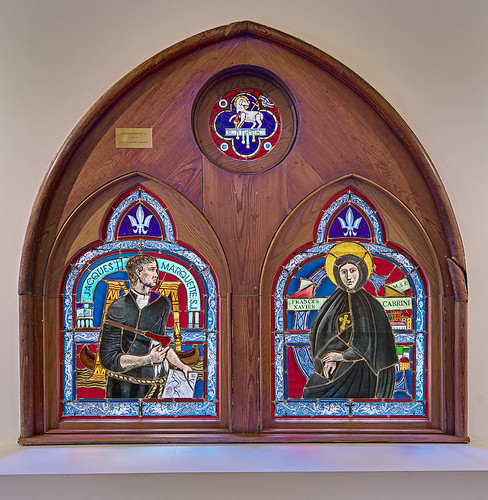
On the left, Jacques Marquette, S.J., who was an early explorer of this region, and who has an open cause for beatification; on the right, Saint Frances Xavier Cabrini.
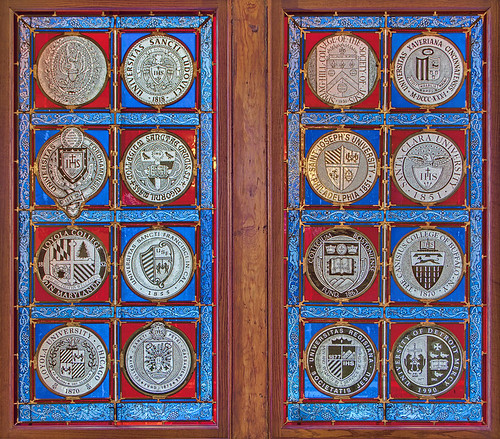
Some of the Jesuit universities in the United States.
The gallery includes works by anonymous Santos carvers from the Philippines, including the following:
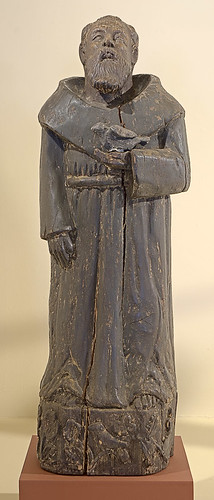
Saint Francis of Assisi.
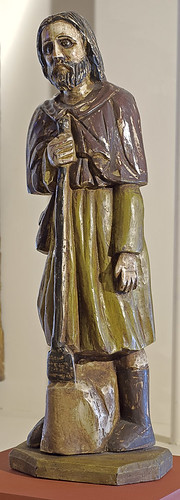
Saint Isidore the Farmer.

Saint Martin.
Another Philippines Santos statue can be seen here.

Santiago de Compostella is from colonial Mexico.
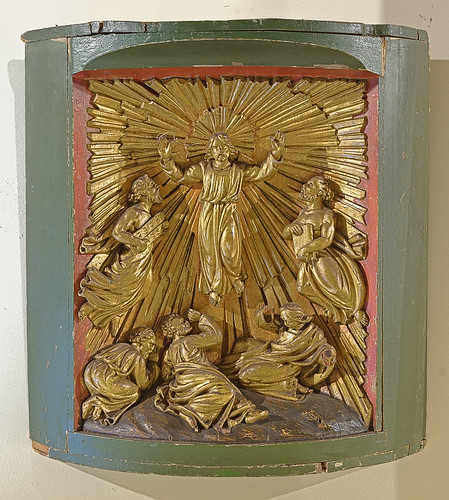
The Transfiguration.
This gallery was once a library, and some of the stained glass windows portray the history of writing:
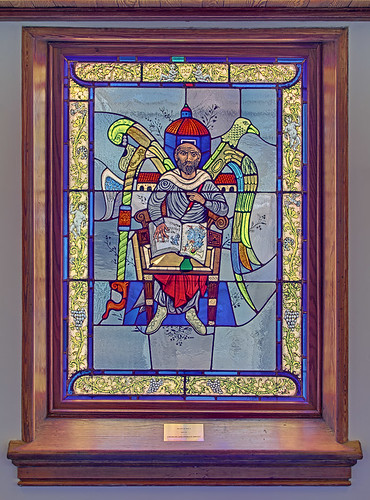
Other windows portray scrolls and the printing press, and this one shows a manuscript codex.
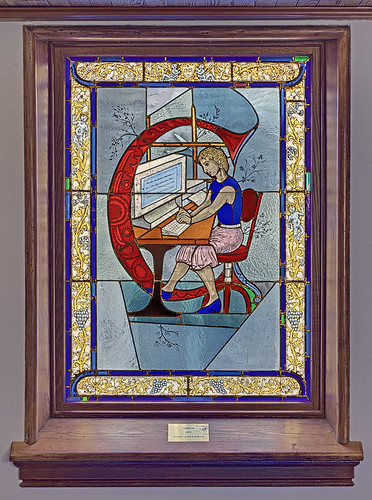
And this one shows a computer. And on the computer screen reads:
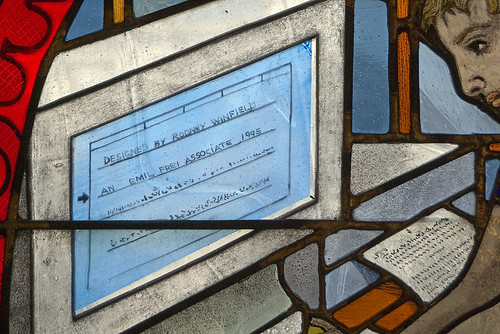
“DESIGNED BY RODNEY WINFIELD
AN EMIL FREI ASSOCIATE 1995”

Painting of the Holy Family, by an unknown artist, ca. 1800.
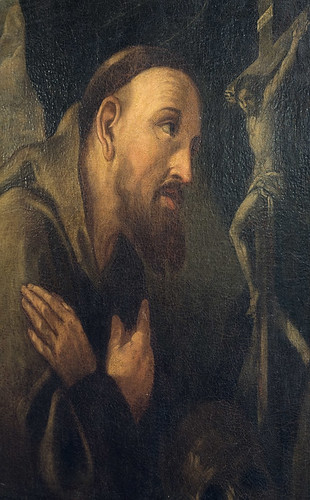
Detail of a painting of Saint Francis of Assisi, by Ludovico Cardi da Cigoli, ca. 1613.
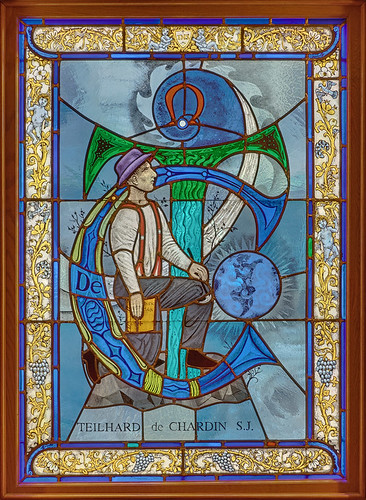
Stained glass window of Teilhard de Chardin???????? His New Age writings are condemned by the Church, and he was deeply involved in the racist Piltdown Man hoax. He remained, however, a loyal priest of the Church and the Society of Jesus.
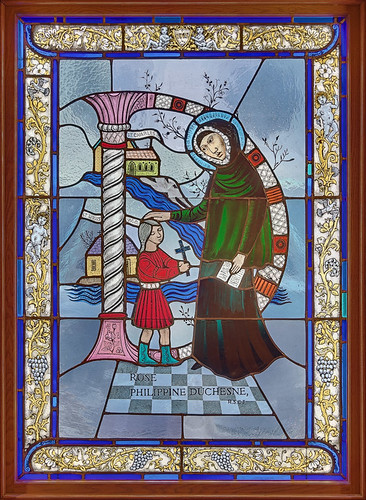
Saint Rose Philippine Duchesne, who lived in the nearby towns of Florissant and Saint Charles; click here for photos of her convent.
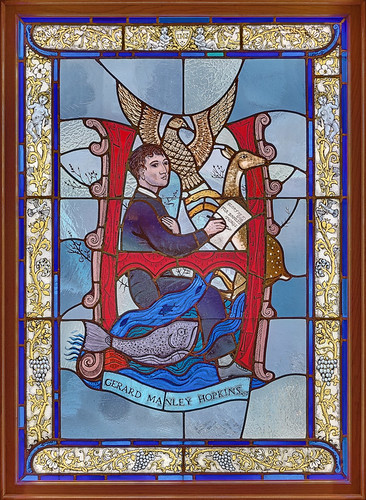
Gerard Manley Hopkins, English poet, Catholic convert, and Jesuit Priest.
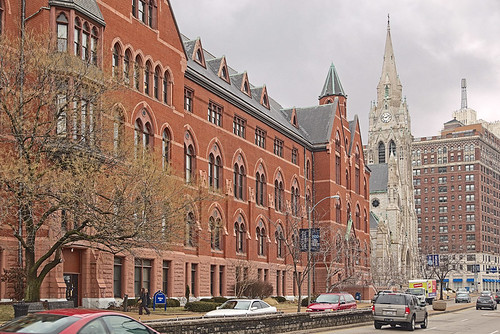
The gallery is in DuBourg Hall, seen here. The gallery is open on Mondays from 11 a.m. to 1:30 p.m.

This great room is four stories tall. According to a history of the museum:
Saint Louis University purchased the land at the corner of Grand and Lindell in 1867 with the intention of moving the campus away from the noise and dirt of industrial St. Louis. Plans were drawn for the "Grand Building," today's DuBourg Hall, though construction did not begin until 1886. The Pere Marquette Gallery was originally the university library and the great timber supports were once illuminated by sun streaming through an atrium that has long since been removed. The cast iron columns and spiral stairs supporting each level once held library stacks. Each level is now used as gallery space for the exhibition of Saint Louis University's collection of art with religious themes.

This still has books. I am normally a bookworm, but didn't have time to look at what volumes were stored here.
The history continues:
Entering from the second floor of DuBourg Hall, a visitor to the Pere Marquette Gallery will find many works brought to St. Louis by the Reverend Pierre Jean De Smet, S.J., in 1845. These Old Master and devotional works were the legacy of the destruction and disruption of the Napoleonic wars, collected from abandoned and war-torn places. The mother of a De Smet classmate, the Baroness Elizabeth De Ghyseghan, and her friends gathered paintings and books to support the efforts of the Belgian Jesuits in St. Louis. These works are found here, at the Historic Samuel Cupples House and in the Collection of the Western Jesuit Missions at the Saint Louis University Museum of Art. Altogether these works constituted the first art collection of St. Louis and were originally all found installed on the walls of DuBourg Hall.

Continuing:
Religious images speak to the heart in the Christian tradition. The third and fourth levels of the Pere Marquette Gallery illustrate expressions of Christian devotion from three very distinct cultures: Retablos, oil painting on tin from colonial Mexico, Greek and Russian Orthodox icons from the 16th and 17th centuries, and Santos images from the Philippine Islands.

Spiral stairs lead upwards. Note the gold fleurs-de-lis on the rich blue carpeting, which reflects the royal French history of this region.

A view of the ceiling.

Stained glass window in the center shows Christ Pantocrator and Saint Francis Xavier; flanking windows show the Evangelists.

Saint John the Apostle and Evangelist, with his symbol the eagle.

On the left, Jacques Marquette, S.J., who was an early explorer of this region, and who has an open cause for beatification; on the right, Saint Frances Xavier Cabrini.

Some of the Jesuit universities in the United States.
The gallery includes works by anonymous Santos carvers from the Philippines, including the following:

Saint Francis of Assisi.

Saint Isidore the Farmer.

Saint Martin.
Another Philippines Santos statue can be seen here.

Santiago de Compostella is from colonial Mexico.

The Transfiguration.
This gallery was once a library, and some of the stained glass windows portray the history of writing:

Other windows portray scrolls and the printing press, and this one shows a manuscript codex.

And this one shows a computer. And on the computer screen reads:

“DESIGNED BY RODNEY WINFIELD
AN EMIL FREI ASSOCIATE 1995”

Painting of the Holy Family, by an unknown artist, ca. 1800.

Detail of a painting of Saint Francis of Assisi, by Ludovico Cardi da Cigoli, ca. 1613.

Stained glass window of Teilhard de Chardin???????? His New Age writings are condemned by the Church, and he was deeply involved in the racist Piltdown Man hoax. He remained, however, a loyal priest of the Church and the Society of Jesus.

Saint Rose Philippine Duchesne, who lived in the nearby towns of Florissant and Saint Charles; click here for photos of her convent.

Gerard Manley Hopkins, English poet, Catholic convert, and Jesuit Priest.

The gallery is in DuBourg Hall, seen here. The gallery is open on Mondays from 11 a.m. to 1:30 p.m.
Wednesday, February 24, 2010
"Starry Eyed Surprise"
AN ARTICLE, Starry Eyed Surpise: NoCo's TWO Observatories, tells of the two astronomical observatories, open to the public, in north Saint Louis County, Missouri.

The article features my photo of the Richard D. Schwartz Observatory at the University of Missouri - Saint Louis, in Normandy, Missouri, which I originally published in an earlier article. An expert on using this telescope blogs here.
NOCO is “The Online Magazine of North St. Louis County”, which according to its publisher, Shannon Howard, exists to “promote all of the positive things that are happening in North County and to hopefully change some minds about what this area really has to offer.”
http://nocostl.com

The article features my photo of the Richard D. Schwartz Observatory at the University of Missouri - Saint Louis, in Normandy, Missouri, which I originally published in an earlier article. An expert on using this telescope blogs here.
NOCO is “The Online Magazine of North St. Louis County”, which according to its publisher, Shannon Howard, exists to “promote all of the positive things that are happening in North County and to hopefully change some minds about what this area really has to offer.”
http://nocostl.com
"Benedictus Deus"
TAKE A LOOK at Benedictus Deus, a blog by Derrick Flannigan of Washington, Missouri, which has the tagline “Musings of a high school theology teacher.”
Also see the fine photo on the blog's masthead, showing a view of downtown Washington from the Missouri River.
http://benedictus-deus.blogspot.com
Also see the fine photo on the blog's masthead, showing a view of downtown Washington from the Missouri River.
http://benedictus-deus.blogspot.com
Tuesday, February 23, 2010
"The Catholicism Project"
FROM THE CATHEDRAL of Saint Peter, in Belleville, Illinois:
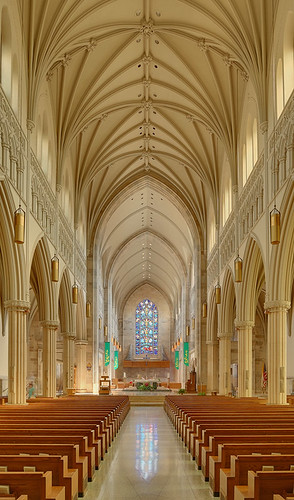
Nave of the Cathedral.
A visual tour of Catholicism around-the-world:
"The Catholicism Project"
(trailer) http://www.wordonfire.org/The-Catholicism-Project/Trailer.aspx
at the Cathedral of St. Peter in Belleville
Thursday, February 25 —
in the Undercroft
Light Lenten Soup 6:30 PM
and at 7 PM — Part One of "The Catholicism Project" (60 minutes)
The Cathedral of St. Peter is pleased to be a "pilot" parish for this exciting series by the excellent Fr. Robert Barron of the Archdiocese of Chicago.
The great heritage of the Catholic Church is presented in a ten-part series, a truly global journey: from the lands of the Bible, to the great shrines of Europe, to the shores and heartland of America, from the mysteries of Asia, to the rich landscapes of Latin America, to the beating heart of Africa – and beyond.
This global vision of the Catholic Church has never been seen in this way before. The Cathedral Undercroft is honored to be one of the very first venues in the US to see Part One of this exciting new series! (It is for adults and those children old enough to understand … At the same time on Thursday night, littler children will have a separate opportunity for “learning about their Faith.”)

Nave of the Cathedral.
Monday, February 22, 2010
Feast of the Chair of Saint Peter
FOR TODAY'S feast in honor of Saint Peter's office of Bishop of Rome, here are two works of art from the Pere Marquette Gallery of the Saint Louis University Museum of Art, on the campus of Saint Louis University. The gallery is open on Mondays from 11 a.m. to 1:30 p.m., and is located on the second floor of DuBourg Hall.
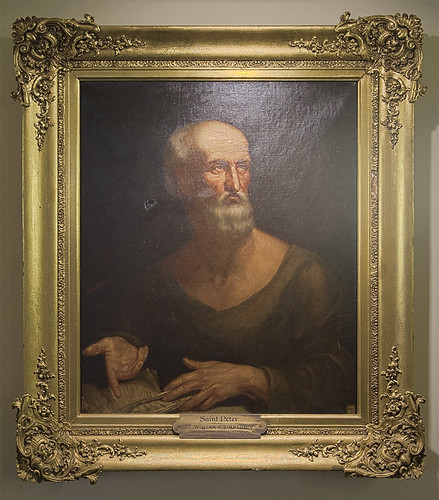
Oil painting, “Saint Peter” by William R. Simpson.
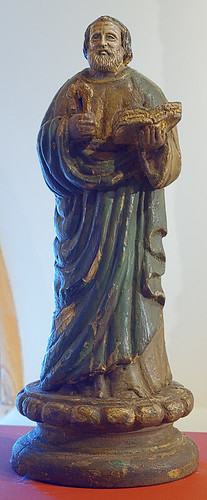
Statue, polychrome and gesso on hardwood with bone inlay, “St. Peter the Apostle” by unknown Santos carver, Philippines, 19th century.

Oil painting, “Saint Peter” by William R. Simpson.

Statue, polychrome and gesso on hardwood with bone inlay, “St. Peter the Apostle” by unknown Santos carver, Philippines, 19th century.
Sunday, February 21, 2010
Some Recent Church Photos
HERE ARE SOME photos of churches that I've visited in the past month.

Saint Luke the Evangelist, in Richmond Heights.
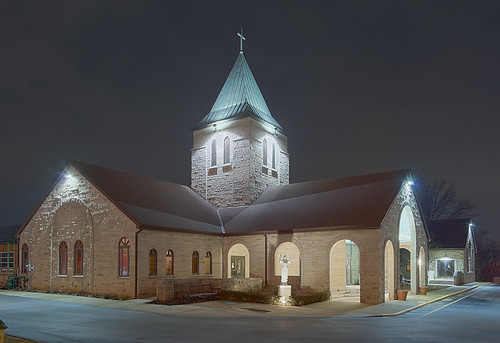
Saint Monica, in Creve Coeur.
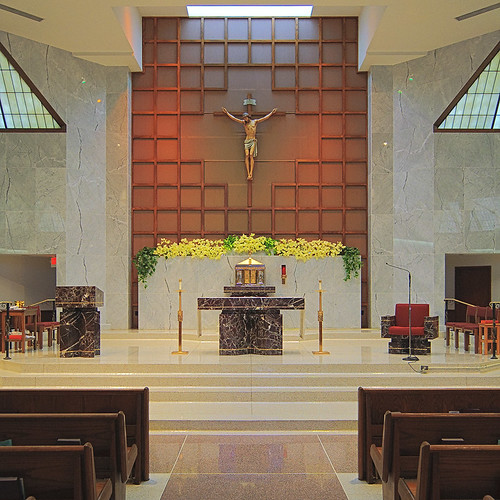
Holy Infant, in Ballwin.
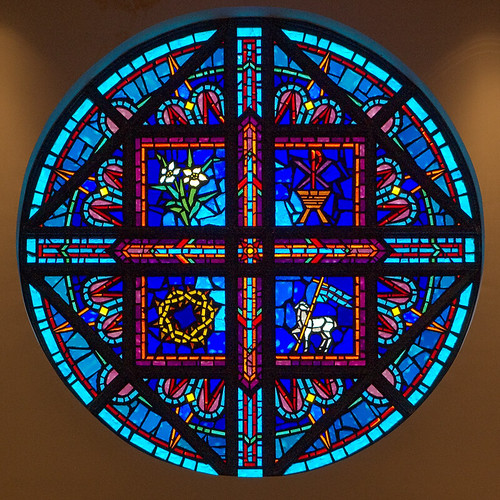
Stained glass window with Christological symbols at Holy Infant.

Incarnate Word, in Chesterfield.
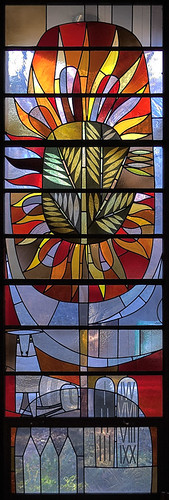
Window at Incarnate Word.
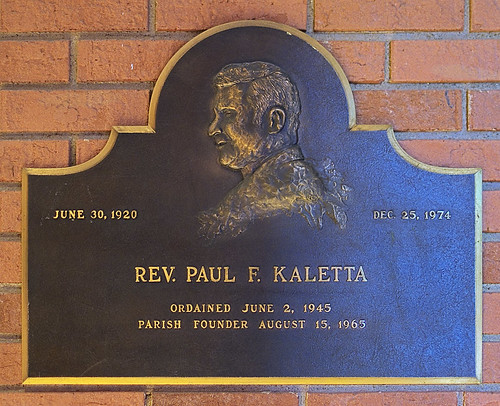
Memorial to Incarnate Word founder, the Rev. Paul F. Kaletta.
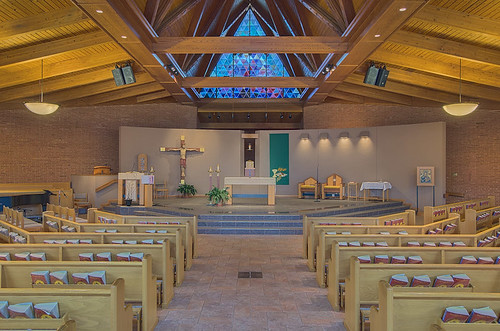
Christ, Prince of Peace, in Manchester.

Immaculate Conception, in Maplewood.
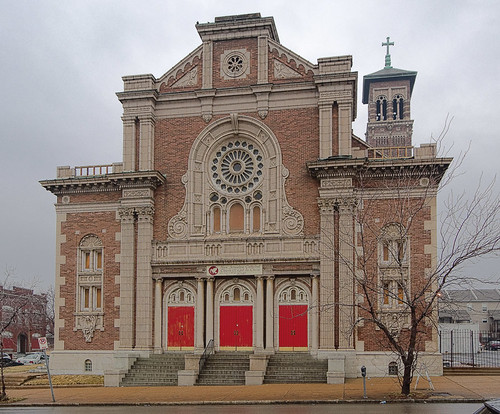
The former Holy Name, in Saint Louis, closed in 1992.

Saint Luke the Evangelist, in Richmond Heights.

Saint Monica, in Creve Coeur.

Holy Infant, in Ballwin.

Stained glass window with Christological symbols at Holy Infant.

Incarnate Word, in Chesterfield.

Window at Incarnate Word.

Memorial to Incarnate Word founder, the Rev. Paul F. Kaletta.

Christ, Prince of Peace, in Manchester.

Immaculate Conception, in Maplewood.

The former Holy Name, in Saint Louis, closed in 1992.
Thursday, February 18, 2010
The More You Do, the More You Can Do
A FRIEND RECENTLY marveled at how productive some people are, and after reflection, came to the conclusion that “the more you do, the more you can do.” I find that to be true myself, with some days being good, and other days bad regarding this — if you find me doing lots of work on this blog, be assured that I am likely doing plenty of other things too.
When I held down a normal job, I often noticed how it seemed that only a few people in a department did about 80% of the work, and wondered what the many other people did every day. [Disclaimer: I often was in the latter category of worker.] This obviously was a problem with many managers, who themselves seemed to do little actual work, but who did spend much time in devising systems to squeeze productivity out of the bulk of the workers. But during the twenty years of my experience, I noticed that these systems rarely worked, and average worker productivity actually went down, with any real productivity gains coming primarily from technology.
Management systems are social technology, and any technology works or fails depending primarily on how closely it reflects reality. Someone with no knowledge of the laws of flight cannot design a successful aircraft, but many management systems are designed by persons who do not have even an approximately true knowledge of human nature.
One problem is the failure to understand the legitimate variety in human behavior and aptitude. Many highly talented people (who do the 80% of the work) are often... different, and a failure to accommodate this kind of person can lead to the failure in an organization, often over trivial matters. Sometimes highly disciplined and competent persons can have an authoritarian (or rather, authoritative) attitude which can be off-putting to those who like to over-manage; this type of worker may resent the intrusion by a manager who is ignorant or incompetent. Also, some people just aren't suited to certain lines of work, and our educational system, which promotes credentials over aptitude, doesn't help.
The management systems, over time, greatly increased the amount of formal control over the workers, who in turn generally hated the new systems and the ever-changing rules. Managers spent their time devising, analyzing, and facilitating these new systems. But managers fail to recognize that slaves are notoriously unproductive. Couple this with the trend to pay managers according to the number of their subordinates and you get an unstable situation of relatively unproductive growth, which eventually leads to collapse.
At one time, the managers were actually the most productive lead workers, who directed their subordinates in the same work according to the best of the workers' abilities. This is an approximation of the natural master-journeyman-apprentence relationship, but this has been largely lost. Nowadays, you get professional managers with little or no actual knowledge of the field, who spend most of their time acting as intermediaries instead of a highly skilled workers.
Workers are often drawn into certain fields by considerations other than natural aptitude, because of money, status, perceived glamor, family or societal pressure, and so forth. By the time they actually enter the field, after extensive classroom training but little practical experience, they may end up being supremely incompetent and quite unhappy doing the actual job. Obviously a virtuous person does even unpleasant jobs to the best of their ability, but this is not a generous attitude to have towards others. Employers tend to be rather inflexible in assigning duties, and thereby tend to pigeon-hole workers into extremely narrow work slots. Ironically, the larger the organization, the harder it is for a worker to get reassigned to other duties, despite the vastly greater opportunities available: this is a great argument for decentralization, and for allowing large amounts of local control over employment decisions.
Holy Mother Church teaches that happiness and good work are closely related. A person who truly has a skill, who internalizes it as a virtue, will practice their skill as second nature, and will find pleasure in performing it. And when a person finds pleasure in their work, they will do more of it. A person who lacks this internalization, no matter how externally motivated they are to perform it, will not find happiness from the work itself, and so will likely be unhappy and unproductive, and no management system can ever correct that.
When I held down a normal job, I often noticed how it seemed that only a few people in a department did about 80% of the work, and wondered what the many other people did every day. [Disclaimer: I often was in the latter category of worker.] This obviously was a problem with many managers, who themselves seemed to do little actual work, but who did spend much time in devising systems to squeeze productivity out of the bulk of the workers. But during the twenty years of my experience, I noticed that these systems rarely worked, and average worker productivity actually went down, with any real productivity gains coming primarily from technology.
Management systems are social technology, and any technology works or fails depending primarily on how closely it reflects reality. Someone with no knowledge of the laws of flight cannot design a successful aircraft, but many management systems are designed by persons who do not have even an approximately true knowledge of human nature.
One problem is the failure to understand the legitimate variety in human behavior and aptitude. Many highly talented people (who do the 80% of the work) are often... different, and a failure to accommodate this kind of person can lead to the failure in an organization, often over trivial matters. Sometimes highly disciplined and competent persons can have an authoritarian (or rather, authoritative) attitude which can be off-putting to those who like to over-manage; this type of worker may resent the intrusion by a manager who is ignorant or incompetent. Also, some people just aren't suited to certain lines of work, and our educational system, which promotes credentials over aptitude, doesn't help.
The management systems, over time, greatly increased the amount of formal control over the workers, who in turn generally hated the new systems and the ever-changing rules. Managers spent their time devising, analyzing, and facilitating these new systems. But managers fail to recognize that slaves are notoriously unproductive. Couple this with the trend to pay managers according to the number of their subordinates and you get an unstable situation of relatively unproductive growth, which eventually leads to collapse.
At one time, the managers were actually the most productive lead workers, who directed their subordinates in the same work according to the best of the workers' abilities. This is an approximation of the natural master-journeyman-apprentence relationship, but this has been largely lost. Nowadays, you get professional managers with little or no actual knowledge of the field, who spend most of their time acting as intermediaries instead of a highly skilled workers.
Workers are often drawn into certain fields by considerations other than natural aptitude, because of money, status, perceived glamor, family or societal pressure, and so forth. By the time they actually enter the field, after extensive classroom training but little practical experience, they may end up being supremely incompetent and quite unhappy doing the actual job. Obviously a virtuous person does even unpleasant jobs to the best of their ability, but this is not a generous attitude to have towards others. Employers tend to be rather inflexible in assigning duties, and thereby tend to pigeon-hole workers into extremely narrow work slots. Ironically, the larger the organization, the harder it is for a worker to get reassigned to other duties, despite the vastly greater opportunities available: this is a great argument for decentralization, and for allowing large amounts of local control over employment decisions.
Holy Mother Church teaches that happiness and good work are closely related. A person who truly has a skill, who internalizes it as a virtue, will practice their skill as second nature, and will find pleasure in performing it. And when a person finds pleasure in their work, they will do more of it. A person who lacks this internalization, no matter how externally motivated they are to perform it, will not find happiness from the work itself, and so will likely be unhappy and unproductive, and no management system can ever correct that.
Paenitemini
FASTING AND SELF-MORTIFICATION are nearly universally observed as necessary means to obtaining a higher end — and an obvious example now are the Olympic athletes, who would not even get to the Games were it not for years of self-denial. The world loves fasting and self-moritifcation for the ends of money or pleasure, but hates it when Catholics do it for a spiritual end. That this hate is directed solely to the Church shows that this hate has its origins in Hell. So we must keep up the effort at denying the world, the flesh, and the devil through penance.
Current norms on fasting derive from the Apostolic Constitution Paenitemini of Pope Paul VI. From the text:
The Holy Father teaches:
Penance must never be done for show, or merely done because “that's what Catholics do”, which is particularly a danger with wearing Ash Wednesday ashes.
Pope Paul VI reminds us of the three penitential practices of prayer, self-mortification, and alms giving, and suggests that episcopal conferences adjust the norms of the practice, depending on local economic conditions: for example, the rich could benefit more from self-denial. The norms given by this apostolic constitution are generous in their mildness, but we ought to be generous in our penance.
Click here for the full text.
Current norms on fasting derive from the Apostolic Constitution Paenitemini of Pope Paul VI. From the text:
...following the Master, every Christian must renounce himself, take up his own cross and participate in the sufferings of Christ. Thus transformed into the image of Christ's death, he is made capable of meditating on the glory of the resurrection. Furthermore, following the Master, he can no longer live for himself, but must live for Him who loves him and gave Himself for him. He will also have to live for his brethren, completing "in his flesh that which is lacking in the sufferings of Christ...for in the benefit of his body, which is the church."Penance supports both the individual and the ecclesial community, helping to restore both to Christ.
The Holy Father teaches:
True penitence, however, cannot ever prescind from physical asceticism as well. Our whole being in fact, body and soul, (indeed the whole of nature, even animals without reason, as Holy Scripture often points out) must participate actively in this religious act whereby the creature recognizes divine holiness and majesty. The necessity of the mortification of the flesh also stands clearly revealed if we consider the fragility of our nature, in which, since Adam's sin, flesh and spirit have contrasting desires. This exercise of bodily mortification-far removed from any form of stoicism does not imply a condemnation of the flesh which sons of God deign to assume. On the contrary, mortification aims at the "liberation" of man, who often finds himself, because of concupiscence, almost chained by his own senses. Through "corporal fasting" man regains strength and the "wound inflicted on the dignity of our nature by intemperance is cured by the medicine of a salutary abstinence."We must not fall into the philosophical traps of materialism — where we think that only the material body itself is important — or of excessive spiritualism, where we view the body as as prison-house of the soul, which needs to be transcended.
Penance must never be done for show, or merely done because “that's what Catholics do”, which is particularly a danger with wearing Ash Wednesday ashes.
Against the real and ever recurring danger of formalism and pharisaism the Divine Master in the New Covenant openly condemned—and so have the Apostles, Fathers and supreme pontiffs—any form of penitence which is purely external. The intimate relationship which exists in penitence between the external act, inner conversion, prayer and works of charity is affirmed and widely developed in the liturgical texts and authors of every era.We shouldn't do penance for mere external reasons, but we should not refrain from penance because it is external. Externals are important, but only if they are means to a higher end. Regarding the ashes of Ash Wednesday, it has been said that if you are proud to show off your ashes, then you should remove them, and if you are embarrassed by showing the ashes, then you should keep them on.
Pope Paul VI reminds us of the three penitential practices of prayer, self-mortification, and alms giving, and suggests that episcopal conferences adjust the norms of the practice, depending on local economic conditions: for example, the rich could benefit more from self-denial. The norms given by this apostolic constitution are generous in their mildness, but we ought to be generous in our penance.
Click here for the full text.
Wednesday, February 17, 2010
The Spring Conference of the Catholic Library Association
AN ANNOUNCEMENT, from the Greater St. Louis Chapter of the Catholic Library Association:
Address:
Visitation Academy of St. Louis
3020 North Ballas Road
Saint Louis, Missouri 63131
11 a.m.--12 noon KEYNOTE Speakers Fr. William B. Faherty, SJ and photographer Mark Scott Abeln inform and entertain us with stories and pictures from their book Catholic St. Louis: A Pictorial History (Reedy Press, 2009). Booksigning follows.The Spring Conference will be held at Visitation Academy in Saint Louis County, Missouri, on March 13th, 2010, from 8 a.m. to 2 p.m.
Address:
Visitation Academy of St. Louis
3020 North Ballas Road
Saint Louis, Missouri 63131
Ash Wednesday
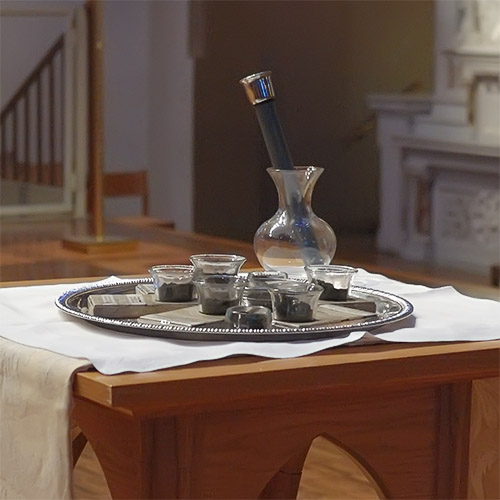
Ashes and holy water aspergillum (sprinkler), for Ash Wednesday, at Saint Francis Xavier Church, in Saint Louis.
Memento, homo, quia pulvis es, et in pulverem reverteris.— The traditional formula said when receiving ashes on the forehead this day.
Remember, man, that thou art dust, and unto dust thou shalt return.
Let us change our garments for ashes and sackcloth: let us fast and lament before the Lord: for plenteous in mercy is our God to forgive our sins...— From the Mass for Ash Wednesday, according to the 1962 missal.
We must remember that Lent has a horizontal aspect also — along with prayer, fasting, and self-mortification, we are to practice almsgiving. In a reading from the Liturgy of the Hours for today, Isaiah tells us that we must deal justly and charitably with others if our penance is to be recognized at all.
Monday, February 15, 2010
Sunday, February 14, 2010
Our Lady of the Pillar
OUR LADY of the Pillar Church, in Saint Louis County, Missouri:
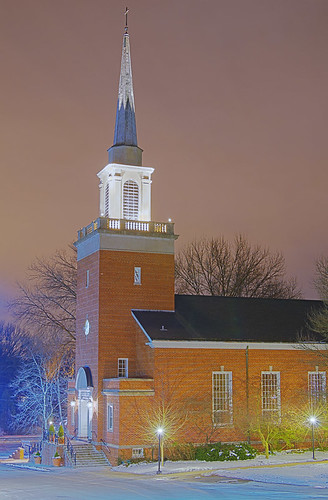
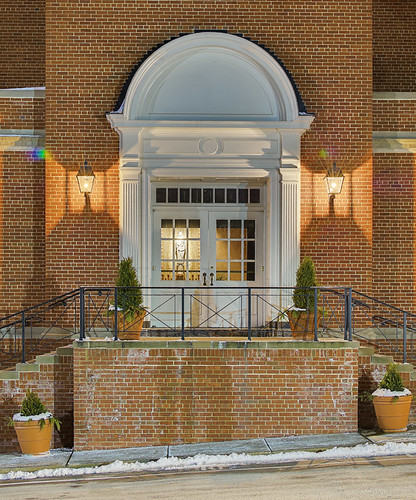
Last Thursday I gave a presentation in the church hall. Many thanks to everyone who showed up! The hospitality, food, beverages, and questions asked afterwards were excellent.


Last Thursday I gave a presentation in the church hall. Many thanks to everyone who showed up! The hospitality, food, beverages, and questions asked afterwards were excellent.
Friday, February 12, 2010
Snow Day
SNOW FALLS reliably and frequently over Saint Louis, but we rarely get very much, nor does it last too long before melting. The climate of this region is quite variable: so if you don't like the weather, just wait a few days and it will change.
The following photos were taken over the past several days.
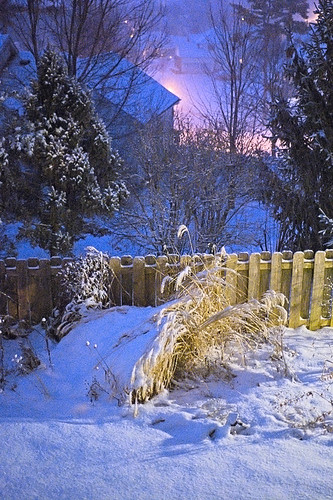
View from my parents' back porch.
You can tell when snow is about to fall — for the land is enveloped in silence, and even nearby noise is muffled. During snowfall, if the wind is not blowing, you can hear the tiny flakes hitting the ground. The quietness of snow is remarkable, giving a sense of calm to even a busy city.
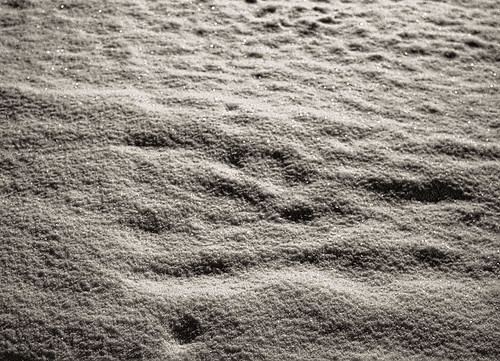
Freshly fallen snow has some interesting texture, sculpted by the wind.
According to the National Weather Service,
The climate of Saint Louis is similar to that of eastern Europe, and also Tokyo, Japan, Beijing, China, and Seoul, South Korea. But the kind of climate found here is completely absent in the southern hemisphere.
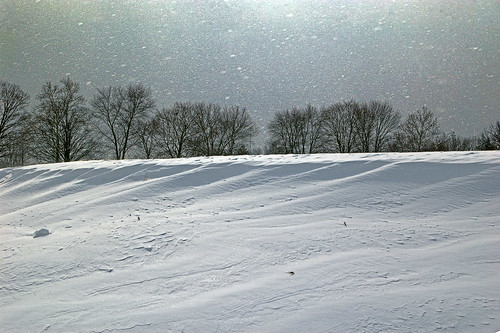
Snow falls over the lake dam at Hillermann Park, in Washington, Missouri.
Snowfall adds some cheer to the land when the lights of Christmas are finally turned off. The beauty of untrammeled snowscapes is captivating, and it can even briefly turn a drab city into a thing of wonder.
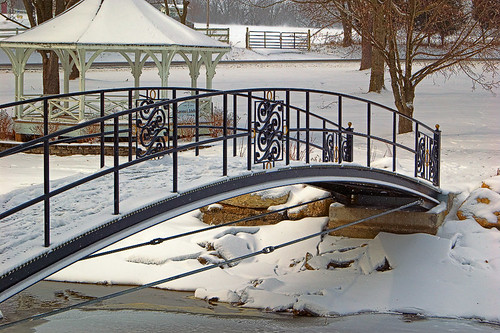
A bridge over an arm of that lake.
Snow lasts briefly enough here that local skiing is not a major winter pastime, and a snowmobile would be a useless expense; however, children quickly make use of the snow we do have, building snowmen and sledding.
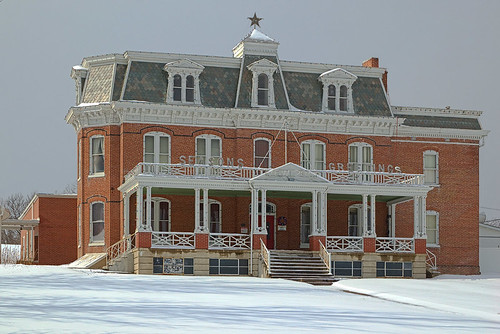
Old Busch home in Washington.
Snow is a natural symbol of purity, renewal, and transformation, so we should not be surprised that this symbol is used in sacred scripture. "If your sins be as scarlet, they shall be made as white as snow" (Isaiah 1:18); Our Lord's garments shone as white as snow at the Transfiguration (Matthew 17:2), which according to Saint Augustine, "signified the Church cleansed from every spot of sin." David prays, "You shall sprinkle me with hyssop, and I shall be cleansed: you shall wash me, and I shall be made whiter than snow," (Psalm 50:8 LXX). Mystical theologians invoke the image a snow-covered landscape in the bright sun: the brightness is so great that our vision dims, and we even risk snow blindness; so is God's glory so bright that we cannot bear to look upon it, and therefore from this comes the mystical language of the "darkness above the light".
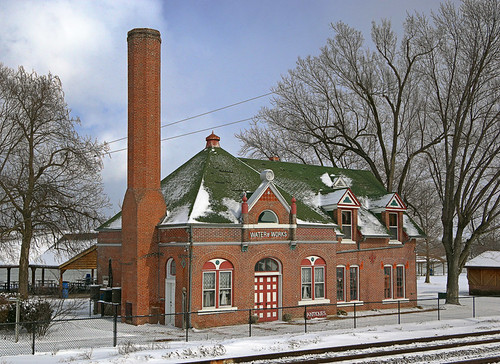
Old water works building on the riverfront at Washington.

Watercress grows in a spring run, at the corner of Smizer Mill and Meramec Station Roads, near Valley Park. Springs hereabouts discharge water at a temperature close to the yearly average — roughly 59 degrees Fahrenheit (15° C.) — and so do not freeze. Although you cannot see it here, steam was rising from the waters, and an aquatic mammal was resting here, before swimming away.
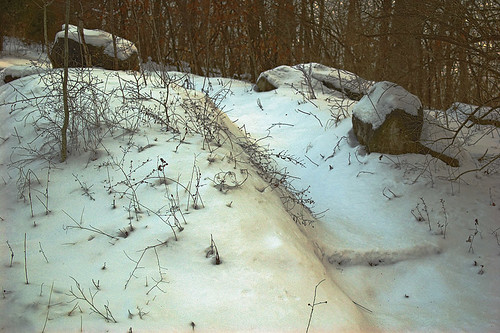
The gloom at day's end is evident on this snow-covered hiking trail at Emmenegger Nature Park, in Kirkwood. There were no tracks yet in this snow, either from human or animal.

The blue light of dusk illumines a snow-covered road and parking lot at Emmenegger. The Meramec River — swift-running and spring-fed and hence never frozen — runs through the background.
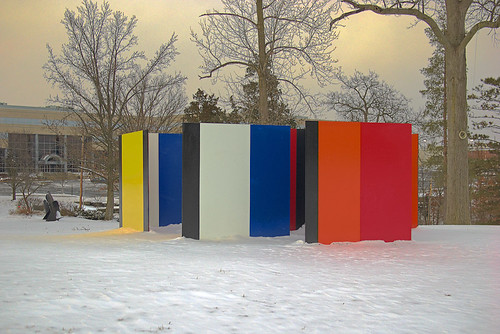
Brightly colored abstract art, at Laumeier Sculpture Park in Sunset Hills. I used to work in the building seen in the background.
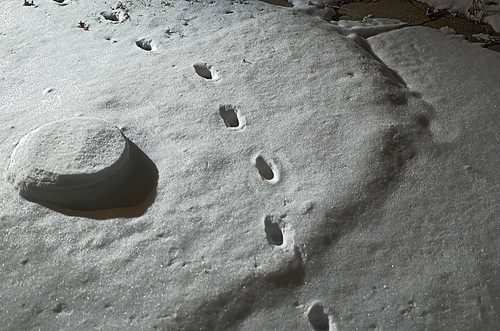
Animal tracks in the snow, at night. As the front and back paw tracks coincide, I would assume this was made by a cat.
The following photos were taken over the past several days.

View from my parents' back porch.
You can tell when snow is about to fall — for the land is enveloped in silence, and even nearby noise is muffled. During snowfall, if the wind is not blowing, you can hear the tiny flakes hitting the ground. The quietness of snow is remarkable, giving a sense of calm to even a busy city.

Freshly fallen snow has some interesting texture, sculpted by the wind.
According to the National Weather Service,
St. Louis is located at the confluence of the Mississippi and Missouri Rivers, and near the geographical center of the US. Its position in the middle latitudes allows the area to be affected by warm moist air that originates in the Gulf of Mexico, as well as cold air masses that originate in Canada. The alternate invasion of these airmasses produces a wide variety of weather conditions, and allows the region to enjoy a true four-season climate...The maximum amount of snowfall, in a 24 hour period, was 20.4 inches, which happened in March of 1890. Snow can be found in Saint Louis between November and April, with trace amounts having historically fallen in October and May.
Winters are brisk and stimulating, but prolonged periods of extremely cold weather are rare. Records show that temperatures drop to zero or below an averages of 2 or 3 days per year, and temperatures as cold as 32 degrees or lower occur less than 25 days in most years. Snowfall has averaged a little over 18 inches per winter season, and snowfall of an inch or less is received on 5 to 10 days in most years....
The climate of Saint Louis is similar to that of eastern Europe, and also Tokyo, Japan, Beijing, China, and Seoul, South Korea. But the kind of climate found here is completely absent in the southern hemisphere.

Snow falls over the lake dam at Hillermann Park, in Washington, Missouri.
Snowfall adds some cheer to the land when the lights of Christmas are finally turned off. The beauty of untrammeled snowscapes is captivating, and it can even briefly turn a drab city into a thing of wonder.

A bridge over an arm of that lake.
Snow lasts briefly enough here that local skiing is not a major winter pastime, and a snowmobile would be a useless expense; however, children quickly make use of the snow we do have, building snowmen and sledding.

Old Busch home in Washington.
Snow is a natural symbol of purity, renewal, and transformation, so we should not be surprised that this symbol is used in sacred scripture. "If your sins be as scarlet, they shall be made as white as snow" (Isaiah 1:18); Our Lord's garments shone as white as snow at the Transfiguration (Matthew 17:2), which according to Saint Augustine, "signified the Church cleansed from every spot of sin." David prays, "You shall sprinkle me with hyssop, and I shall be cleansed: you shall wash me, and I shall be made whiter than snow," (Psalm 50:8 LXX). Mystical theologians invoke the image a snow-covered landscape in the bright sun: the brightness is so great that our vision dims, and we even risk snow blindness; so is God's glory so bright that we cannot bear to look upon it, and therefore from this comes the mystical language of the "darkness above the light".

Old water works building on the riverfront at Washington.

Watercress grows in a spring run, at the corner of Smizer Mill and Meramec Station Roads, near Valley Park. Springs hereabouts discharge water at a temperature close to the yearly average — roughly 59 degrees Fahrenheit (15° C.) — and so do not freeze. Although you cannot see it here, steam was rising from the waters, and an aquatic mammal was resting here, before swimming away.

The gloom at day's end is evident on this snow-covered hiking trail at Emmenegger Nature Park, in Kirkwood. There were no tracks yet in this snow, either from human or animal.

The blue light of dusk illumines a snow-covered road and parking lot at Emmenegger. The Meramec River — swift-running and spring-fed and hence never frozen — runs through the background.

Brightly colored abstract art, at Laumeier Sculpture Park in Sunset Hills. I used to work in the building seen in the background.

Animal tracks in the snow, at night. As the front and back paw tracks coincide, I would assume this was made by a cat.
Subscribe to:
Posts (Atom)


